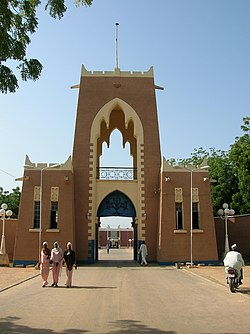Hausa/Lesson 3
Appearance
< Hausa
Lesson 3 – Gender
[edit | edit source]
 Kanṑ (help·info), one of the most important Hausa-speaking cities, is a feminine noun.
Kanṑ (help·info), one of the most important Hausa-speaking cities, is a feminine noun.Gender assignment
[edit | edit source]Like in many other languages, nouns in Hausa can be either masculine or feminine. While gender assignment is somewhat arbitrary, there are a few patterns:
- The grammatical gender of nouns always corresponds to natural sex. For example, mùtûm ("man") is masculine, while màcè ("woman") is feminine.
- Nouns ending in -a are often - but not always - feminine. Ruwā ("water") is an example of a masculine noun ending in -a.
- The names of countries, rivers and towns are tipically feminine.
- Some nouns may be either masculine or feminine. For example: kā̀kā ("grandfather" or "grandmother").
- Plural nouns are not marked for gender.
Forming the feminine from a masculine noun
[edit | edit source]The feminine form of most masculine nouns referring to people or animals is derived as follows:
- A final -ō or -ū is replaced with -uwā.
tsuntsū ("male bird") → tsuntsuwā ("female bird")
- A final -ē or -ī is replaced with -ìyā.
Bàhaushḕ ("Hausa man") → Bàhaushìyā ("Hausa woman")
- In some cases, -ī is replaced with -ā instead of -ìyā.
jā̀kī ("male donkey") → jā̀kā ("female donkey")
